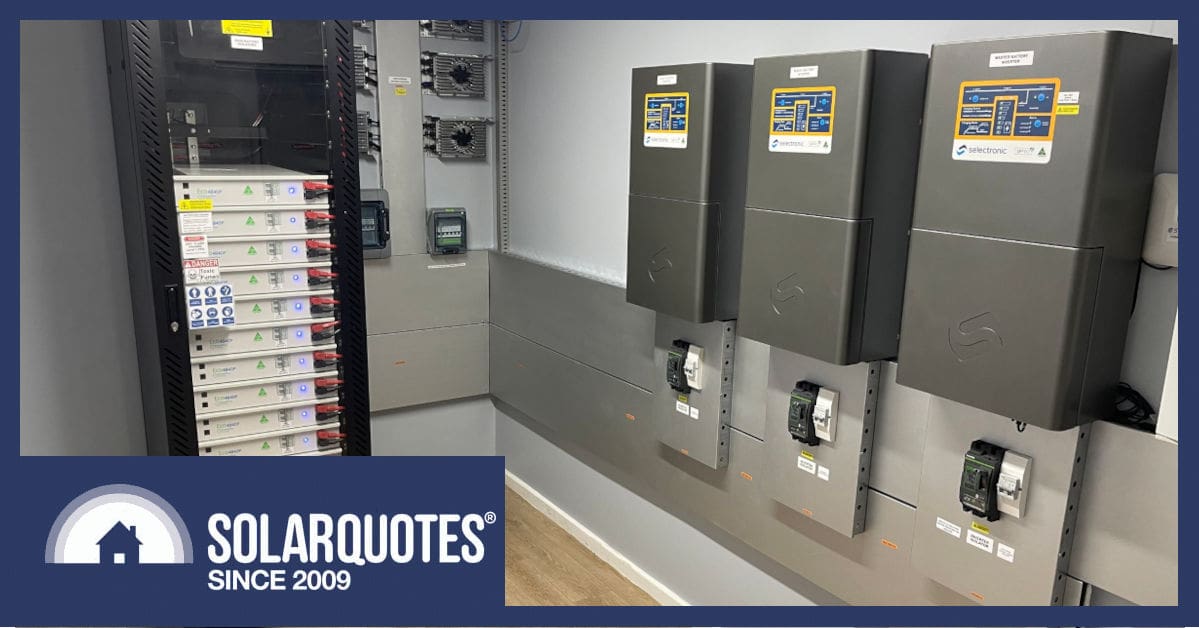
One battery and three of the best inverters made anywhere.
It wasn’t so long ago that 1kW was the average size of a solar power system. Keen customers bought 1.5kW. The first 2kW job I did was on a garage full of Mercs that overlooked a winery. Fast forward just a decade and a half and 6.6kW has become the basic measuring stick for quotes, with average system sizes surpassing 10kW.
As system sizes have grown, so has demand for 3 phase solar power.
If you’d like to brush up on what I mean by 3 phase power, take a look at this explainer before you read on.
We also recently wrote about the many different options now available for 3 phase hybrids using batteries.
However there are still questions to be answered about 3 phase solar, and battery backups, as demonstrated in the still-active comments section on this blog from 2018.
I’ll be addressing one comment in particular:
“I recently got a quote for a battery solar system for my 3 phase home, the sales person said I would need 3 separate solar batteries of 3kw each being the best way to do it which of course is going to inflate the cost, is this true I would need 3 batteries and is there a way to only use the one battery by way of certain modifications?”
Unfortunately, there’s no simple answer to the question.
Rather, different brands and different models will address the challenge in different ways. It’s also possible this particular sales person has misinterpreted the rules.
When installing solar in a 3 phase home, you may need to balance three inverter capacities. But that doesn’t necessarily need three batteries. Read on as we delve into why.
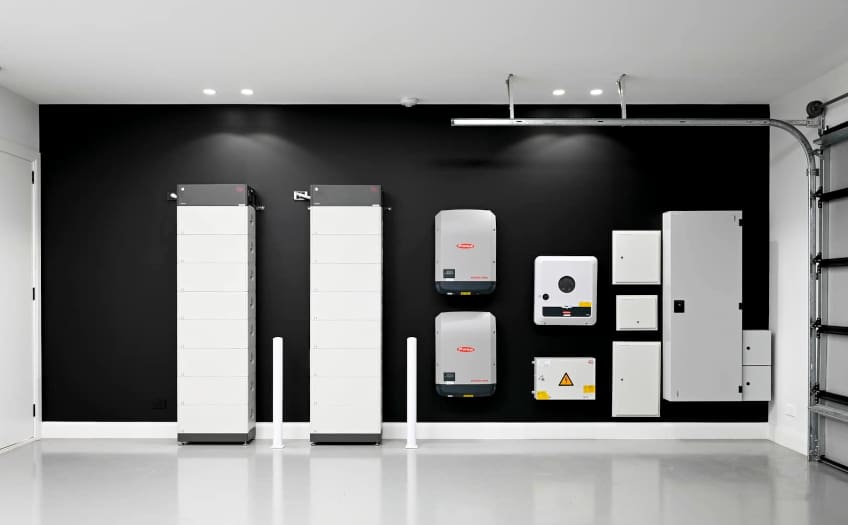
One x Fronius Symo Gen24 with parallel BYD battery stacks and two x Fronius Symo Snap inverters. Brilliant.
Three Benefits Of 3 Phase Electricity
- Where single phase electricity cycles 50 times per second, the beauty of 3 phase is the smoothness of supply. Instead of a pulse pushing and pulling 180° apart, 3 phase has successive overlapping pulses at 120°. This means motors run smoothly, efficiently and don’t need special circuits to start them rolling. That said, things like smart-drive washing machines and inverter air conditioners (with brushless DC motors) arguably mean the smooth superiority of 3 phase is becoming irrelevant.
- For the same amount of energy, a 3 phase circuit needs one third of the current, so the cabling required is lighter and therefore cheaper.
- Perhaps the biggest benefit of 3 phase: you can pull more power from the grid.
Higher Capacity
A nominal single phase 63amp service, at 230VAC, delivers 14.5kW to your house. This is just enough to run two ordinary EV home charging outlets.
If you’re hosting a home wedding, it’s enough for a bain marie, a deep fryer, two urns and the bride’s hair dryer.
By comparison, a 3 phase service can deliver 43.5kW.
That’s almost as much peak power as my 12 year old electric kei car, and a quarter of the power of a basic Tesla Model 3 or an old V8 Commodore.
At your home wedding, you can double your catering service and still have capacity for a live band (just don’t let them unplug the spit roast for their amps).
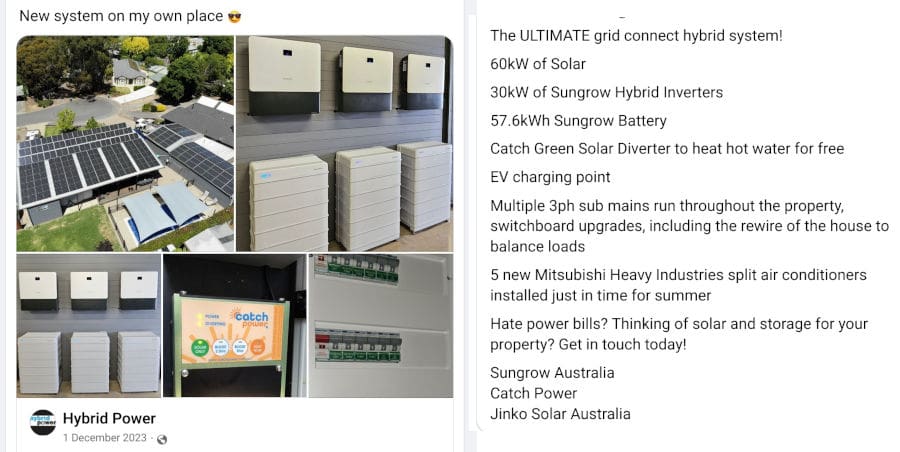
When good installers go one better you get 60kWp on the house. Image credit: Mark Bates.
The take-home message is this: as we electrify our lives and move to electric mobility, 3 phase will be increasingly necessary.
So if you want more solar power, having 3 phase means you can generally get 30kW of inverter capacity approved, and as much as 60kW of solar panels on the roof. That’ll yield about 265kWh per day where I’m from.
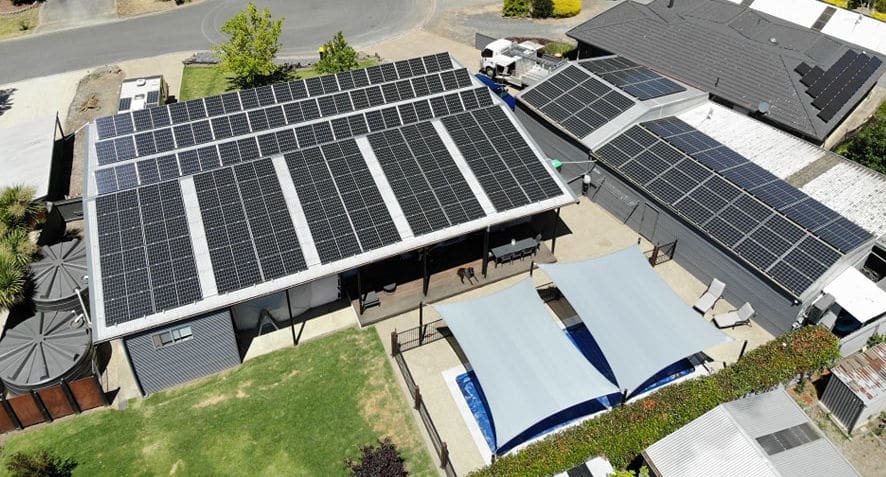
60kW of solar power is well used with an appetite of 130kWh/day to run air-conditioning and pool heating
Challenges To Consider
When 3-phases Limit Your Solar Yield
Under ASNZ:4777 standards, 3 phase inverters must have balanced output. That means an even amount of power on each phase.
For example, you could have a 20kW inverter, but a solar export limit of 1.5kW per phase (applicable in WA)
Here’s how that can create an artificial ceiling on your solar yield:
Say it’s sunny at midday; the car charger is using 7kW on phase A, and a large air conditioner is using another 7kW on phase B. That means a total load of 14kW.
For balance, the hot water service runs on phase C, but because it’s already hot, there’s no load on phase C. The export limit means the inverter cannot produce more than three times 1.5kW, a total of 4.5kW.
Despite potentially having plenty of sunshine, the house will still only be able to generate an even 4.5kW of solar power. It will import, and be billed for, the other 9.5kW required to power the car charger and air conditioner.
If the thermostat closes to turn the 3.6kW hot water service back on, inverter output can increase to 5.1kW per phase, or 15.3kW. It’s counter intuitive, but increased consumption means total generation increases, and imports fall to 2.4kW.
If the Distributed Network Service Provider (DNSP) allows average phase limits, rather than ‘weakest phase’ settings (required in New Zealand, for instance) then this problem may be alleviated.
Balanced Output Makes Backup Awkward
If you want the lights on when the grid fails, that’s easy enough.
Where 3 phase hybrid systems fall down, is the fact that for a nominal 10kW inverter you’ll only get 3.7kW (at best) as a surge rating for a single phase load.
If you have a 450W motor, like a small rainwater pump or heat pump hot water unit, then the inverter may struggle to get it started.
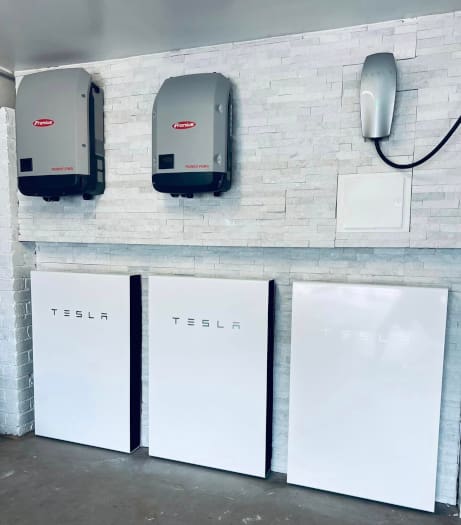
Beautifully executed Tesla Powerwall and Fronius combination from Scott Mason. Powerwall cannot offer 3 phase backup.
Will Three Single Phase Inverters Work?
Using three single phase inverters can get around some of these problems. They will follow individual phases, independently meeting whatever load is imposed.
It’s feasible to have different brand and size inverters running as conventional, grid-connect solar, provided you can meet DNSP technical compliance.
Given the appropriate switchboard segregation, single phase hybrids can offer full-rated capacity for whatever off-grid surge load you need.
In fact, Solar Edge had to withdraw its 3 phase hybrid model. Instead it now offers a special backup gateway that disconnects 3 phase appliances and then bridges everything else together, to offer whole-of-home single phase backup. A clever electrician could probably do the same with other brands of equipment.
However, if you want heavy-duty backup of all phases you will need three inverters and three batteries, plus a switchboard arranged to run three separate systems. Being separate, they will not form a 120° synchronised grid to run a 3 phase machine (unless you buy the absolutely incomparable Selectronic SPPro).
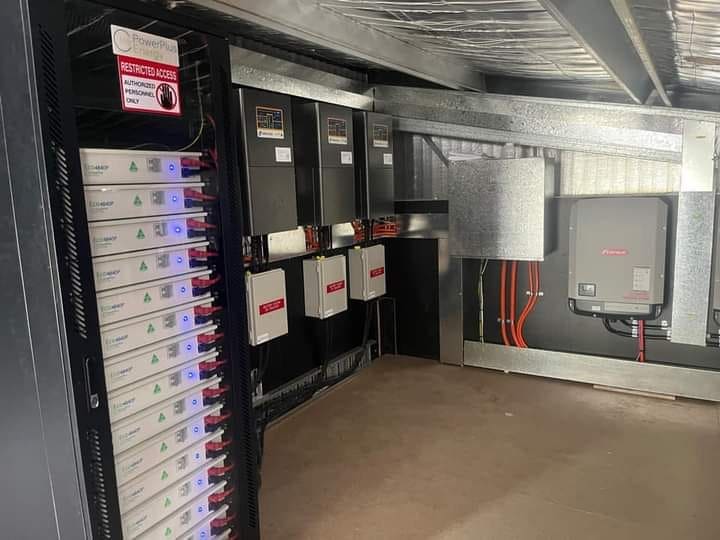
Another beautifully executed 3 Phase Selectronic system from Peter Cunningham.
The other thing many miss is a phase failure system that will turn off all inverters in the network if one dies.
Some brands can be coupled to perform this more important function, others will need a stand alone device at more expense to make any potential inspectors happy.
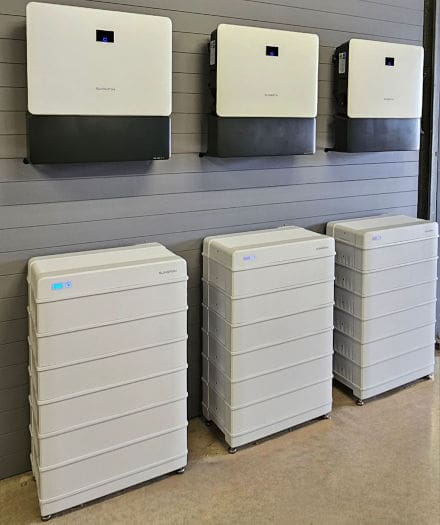
Three 10kW Single Phase Hybrid Sungrow inverters.
Don’t Start Over
I’m sure many electricians have installed unbalanced solar power systems and just ticked the DNSP box to say: ‘yessir it’s compliant’.
Some combinations of hardware are simply impossible to arrange evenly if the customer doesn’t have the budget to bin everything and start again.
In my opinion, the technical breach isn’t as immoral as making e-waste out of good functioning equipment.
So Do You Need Three Batteries For a 3 Phase House?
In most cases you probably don’t need three batteries, but batteries themselves can be modular, you may need more than one inverter, so there’s no clear answer to the question.
As 3 phase power becomes more common, we may see more brands lifting the bar and bringing out more capable products for simpler and more flexible systems, but it’s an incremental transition.
Don’t Worry Too Much
It’s down to your installer to marry the technical solutions to your requirements, while following all the rules.
As a solar customer, it’s really important to remember to document exactly what you want and decide on your budget.
Take your expectations to your installer. Maintain your priorities, but be prepared to take advice — things like backing up a whole property can quickly become impractical, or serving multiple buildings may be impossible with a particular brand or model.
Sticking to your guns won’t help if a certain DNSP connection rule can’t be met, but abandoning mains power never makes much sense either.
Striking a balance between budget, capability, and compliance can be difficult, but if treating the grid with contempt is more your style, it is possible. Just be prepared for some fearlessness in invoicing.

 RSS - Posts
RSS - Posts



We have 22Kw panels and a 22Kw BYD HV on a 3 phase connection. We ended up going with one 10KW Symo and one 10KW Symo Hybrid with the battery connected to it. We decided on only one Hybrid because we didnt really have space for a second battery and the large stack matches the peak DC output of the Hybrid pretty well. Also two batterys and two Gen 24 Hybrid means you have a beast of a switchboard and ours is big enough already. We just had to choose what circuits we back up and the only 3 phase load we have is the Wattpilot. So far we are very happy with the solution delivered by Solarwide Sunshine Coast.
I thought 3 phase inverters could support “Unbalanced loads” (usually 100% on the spec sheet these days).
By this I mean if you have 5kW of panels (& Sun), a 10kW 3 phase inverter will be able to supply a 3.3 kW load on phase 2, nothing on phase 1 and 1.67kW on phase 3
It shouldn’t have to output 1.67kW on every phase
We don’t have net metering per phase here in NZ, and if I’m using 1.7kW on one & supplying 1.7kW on another, I’m paying retail on the usage & getting the feed in rate on what I’m supplying.
What I’d really like 13 kW (10kW effective) of panels and a 30kW hybrid inverter that would let me switch up to 10kW of my solar generation across whichever phase as I need it (and sufficient battery capacity and input/output to maintain that) but that doesn’t seem to exist at any price point here .
Check Goodwe Inverter they go up 30 kw 3 phase for unbalanced grid … which is what you are really trying to balance with byd batteries Search for goodwe unbalanced output on YouTube.. I have a 15kw goodwe hybrid and sungrow 10kw hybrid both with batterys .. The sungrow cannot do unbalanced grid
I have a 10.8 kW 3 phase system with a Fronius 10kW inverter. The system is about 5 years old. I’d like to replace the inverter with a hybrid. Ideally I would like a 15kW inverter and add extra solar panels (plenty of roof space) however I have have struck problems.
1/. The panels have installed have slipped off the CEC approved list. Therefore an installer technically cannot sign off on changes to the system, even changing the inverter. Some might but….. This means that to get my improved system I have to junk all my existing panels (all working well) which is ridiculous and certainly not green or clean.
2/. Fronius doesn’t do a 15kW 3 phase hybrid and the 10kW system would only give a third per phase (your article says 3.7kW) and this would not run my induction cooktop.
3/. Battery prices have gone up, not down over the past few years and installation prices also seem to have gone up so I am getting quotes around 40K for a new system
4/. The Selectronic gadgets would add something like $30 thousand dollars to my system if I somehow got them installed, by one estimate.
So I can’t correctly install batteries without throwing away a functioning system and I can’t get a 3 phase hybrid system big enough to run my house properly. Presumably such things exist for businesses but I don’t know how to access them.
Frustrated!
I believe that there is a Goodwe 15kW 3 phase hybrid but I am reluctant to use Goodwe since I have one on a holiday house and it doesn’t work properly. One string has problems with grid voltage.
Hi Tim,
I believe Sungrow have newer and larger hybrids coming, as do other brands. It may be worth checking how may phases your induction cooktop is connected to. Mine is a 900mm 5 burner rated at 11kW, but table C5 in AS3000 means it’s quite acceptable to have it on a smaller single phase circuit. Stoves don’t run flat out all the time.
A 10kW Fronius Gen24 will actually cope with 3.68kW Continuous (10.0kW in total at once though) 4,13kW overload for 5 sec I’m reliably informed and if you add it in parallel with your existing system they’ll both appear on the same monitoring portal.
file:///C:/Users/antho/Downloads/SE_QG_Symo_GEN24_Full_Backup_EPS_EN_AU.pdf
We have a 10kw Symo and a 10kw Symo Hybrid and they work together seamlessly. Yes you only get a battery backup on the Hybrid circuits but just add a Hybrid and put the new panels through it.
Thanks, I’ve had a look at them and they look good, how noisy is the 15kW Goodwe?
I’m not looking to be able to run all my stuff at once in the event of a power outage, but I would like to be able to have as many things work as I can (without spending gazillions).
I don’t need 30kW, what I need to be able to do is switch what I generate (0-10kW) to the phase where I need it. Also, running an inverter at 30% load has got to be good for it’s lifespan? (Though probably at some small percentage cost of efficiency)
I have things like a 0.9kW water pump that needs to work all the time (not too much of a load, but I don’t know how much inrush current it requires)
Things that I could leave off protection (but would like to include if possible include heat pump hot water (1.5kW) an Induction hob (up to 9kW, but 5kW on average), double oven (up to 6 kW, but 3.5kW on average), Aircon (x2 @ up to 3.5kW ea but usually 1-1.5kW ea)
Oh and I have 2x Tesla EV chargers (but those are 3 phase & I can control their ampage)
If I turned everything on & up to max, I’d blow out my limit on all 3 phases 🤣
The Goodwe has one (at least ) internal fan and 3 substantial fans per phase output on the back if you are running 10 kw on one phase from the battery I expect the fan would ramp up you made need to check the specs <45 dm (but thats and see what the sound level is at 1 meter I haven't been able to get mine to ramp up as it's power sharing and balancing the sungrow unit . very effectively
From the 15 kw you will need to check the size battery modules you need to meet your power expectation
Well there have been some interesting comments and expectations in this thread. But then everybody has their own ideas. So I’ll share my thoughts. I have 13kW of solar, a 10kW 3ph Sungrow hybrid inverter and 19.2 kWh sungrow battery. So I don’t get the comments re needing 3 batteries nor the one stating sungrow can’t manage unbalance grid power. I have our light circuit and one power circuit connected to “inverter backup” terminals. I wanted our 2nd. Power circuit also connected but typical lazy electricians/installers determined it was too hard and didn’t do it, but I’ll get that fixed in due course. My A/C, HWS, ovens and induction cooktop are not connected to backup supply. However, no matter what I am running, provided there is enough solar, I can still feed my allocated/limited 5kW into the grid. So I don’t get the comment that Sungrow can’t support unbalanced grid.
Because it has the built in backup function, “backed up” circuits always run through the inverter so the total load can’t exceed 10kW but they can be 100% unbalanced, so technically I could run my cooktop and or ovens as long so I don’t exceed 10 kW no problem If I put in a 15kW inverter ,,,(which I don’t currently want to do because the I can’t be part of a VPP but will in the future) I could run my whole house through the inverter even without grid support.
I have an EV so have a portable 3ph charger and the 1ph trickle charger. Which I use as Required.
Since having it installed (sept 21) I’m currently just over $100 in credit and have already withdrawn $350 credit from the account.
I haven’t found any situation where my system hasn’t met my needs.
So I think needing 3 batteries to have a 3 ph system would depend on having some very specific requirements.
And no I am not an electrical engineer, or electrician or solar installer, but I am an engineer, an aircraft tradesman, and after significant research specified the system that I wanted installed. Which does everything I wanted.
I had a 3 phase supply and a small by today’s standards 3.4kW system on only 1 phase installed in 2011. When the time came to upgrade the solar in Feb 2023, I decided to drop to a single phase system (2 of the 3x 25mm2 XLPE cables disconnected behind the meter) as all the 3 phase inverter and battery options seemed too prohibitively expensive. Also I live in Tassie and am allowed an 80amp main switch as my current limiting device considering my mains cable size. With all the insulation I’d installed in the ceilings and walls and the double glazing, my heating bills and total power needs dropped substantially. I squeezed 9.5kw of panels on the roof and as my EV (BYD) can only charge at 7kw single, the 3 phase supply just wasn’t needed. I initially planned on getting a battery in 2024, but the 9.5kw of solar has decimated my bills enough. Furthermore, my BYD’s V2L means I could install 2x essential services red outlets (1 in the kitchen) running off a caravan inlet plug next to my car charger that aren’t connected to anything else. Whenever there’s a power failure I can plug in the car to the caravan outlet and run the fridge and portable induction cooktop no sweat. Yes, very manual solution but it works for me.
We have 9.7 kW of solar panels with Enphase IQ8 micro-inverters on a 3-phase system. Is there a battery that would work in our situation?
Have a look here JD.
Enphase or Tesla are fine for single phase but others are better for true 3ph backup
https://www.solarquotes.com.au/blog/3-phase-battery-backup/
Hi Anthony. We’re about to install a 12.32kW solar system with 16kWh battery storage (Sungrow) and 10kw 3 phase Sungrow hybrid inverter as part of our new home build. The new home will be completely electric with induction cooktop, a 3 phase reverse cycle fujitsu aircon (18kw), hotwater heat pump and provision for a 3 phase ev charger. Given the commentary above regarding Sungrow not being able to have unbalanced loads should I be looking to add an additional inverter now rather than later? I’m keen to understand the possible cons of the proposed setup before droping $26k. Cheers Jason
I am getting a 14kw system using enphase microinverters and a powerwall and am interested to know how the microinverters will work across the 3 phases.
Hi Ian,
Your single phase micros will be spread evenly across the 3 phases, so only one third of the enphase units will be available for backup when there’s a grid outage. Generally the Tesla will only handle 5kW of AC coupled solar anyway.
Here is a question for you. My 3 Phase system comprises 15kW of panels, feeding into a 10kW Fronius Gen 24 Hybrid inverter. The export limit is 10kW in total at any one time (so it’s 3.33kW per phase). In summer (and for about 5 months of the year) this ‘oversized’ array goes into ‘clipping’ for about 5 hours between 10.30am to 3.30pm. I estimate that there is at least 2.5kW of ‘unused’ clipped power for 5 hours each day. Is there any way of heating a HWS load by tapping-off the DC power from the panels at the inverter’s input – and feeding this to the heating element of a HWS? Francesco.
Hi Francesco,
What you’re talking about isn’t really feasible because you’d be looking for a device that acts like a second MPPT on the DC side of the inverter.
There have been devices made that us solar DC to heat water directly, but you can’t have one of those connected to an array AND an inverter, and switching DC is a bit of a fools errand unless you can get a solid state device to do the work.
I live in regional NSW and have 2 single phase inverters (Fronius and Solaredge) and about 17kW of panels.
I also have 2 Powerwall 2 batteries connected to a single Tesla gateway.
When I was sold the second battery with the Fronius inverter, in pre-sales discussion the sparky told me that both inverters could be used to power the home/batteries in a blackout.
On the day of install the sparky advised me that only one inverter could be used to power the batteries in a blackout.
I am pretty disappointed about that, but I do find 2 batteries is great for avoiding peak hour power charges on my time of use plan.
I also like being able to pull up to 10kW from the batteries rather than be limited to 5kW with a single battery – this is handy at dinner prep times when we have an aircon, oven, hotplate and microwave all simultaneously pulling load.
I would love any advice on how I can use both inverters during a blackout situation.
Hi John,
You’d need to speak to a SolarEdge guru but I think what you’re encountering is that the PW2 doesn’t like more than 5kW of AC coupled solar in an outage. Fronius can be throttled to suit with a comms cable but I’m not sure SE will respond the same way.
Am I missing something here? What would the issue be with connecting the 3 inverters in parallel across the single battery bank, therefore only needing 1 battery for a 3 phase set up?
I currently have 3 inverters (running as single phase since I don’t need 3 phase) across a single 80kWh battery bank and have been totally off grid for about 12 years. This is my second system and my original 3.6kW system runs the shed and pool.
Unless something goes wrong, the back up generator only cuts in for a few hours about a dozen times a year during winter.
Kevin
Hi Anthony. I have a Franklin single phase battery which has an inbuilt inverter. My house is three phase, how come when i switch my air conditioner on at night when no solar is available, my battery provides 5kw to my house and normally with air con off the battery provides 1.1 to .9kw and the power from the battery provides any other power requirements. Also Would it be true that the 5kw coming from my battery should not be occurring as there has been incorrect wiring of the phases in the installation as i do not want my battery to provide power to my AC.Regards Hans
Hi Hans,
I’m not very familiar with the Franklin offering, other than to say they’re big in the US, where the peasants all have 110VAC appliances and 3 phase isn’t really a thing.
Is your aircon a single phase unit? ducted? 5kW is a fair whack of energy so I wonder if you’ve run it happily for some time or is the 5kW number something it used for a few seconds before turning off? (A 3ph A/C unit won’t function on single phase but might try for a while before hopefully it operates an internal overload and doesn’t burn itself out.)
It certainly sounds like you need to contact the installer and ask them how it’s wired and get it fixed. AC doesn’t play well with batteries unless it’s daytime, you are vigilant and have a lot of solar.
Hi Anthony. Thanks for your early reply. My ducted Air Con is on three phase. And when i switch off my 3 phase supply the 5KW from the battery stops and the grid and Solar supplies the 5KW and and any other power requirements. I believe the installers have wired up the wrong circuits. The installers are now playing hard ball to rectify the circuitry so battery does not drain exponentially, The install has a 5 year warranty. The install was done 3 months ago. This only came to my attention when there was a power outage. Regards Hans.